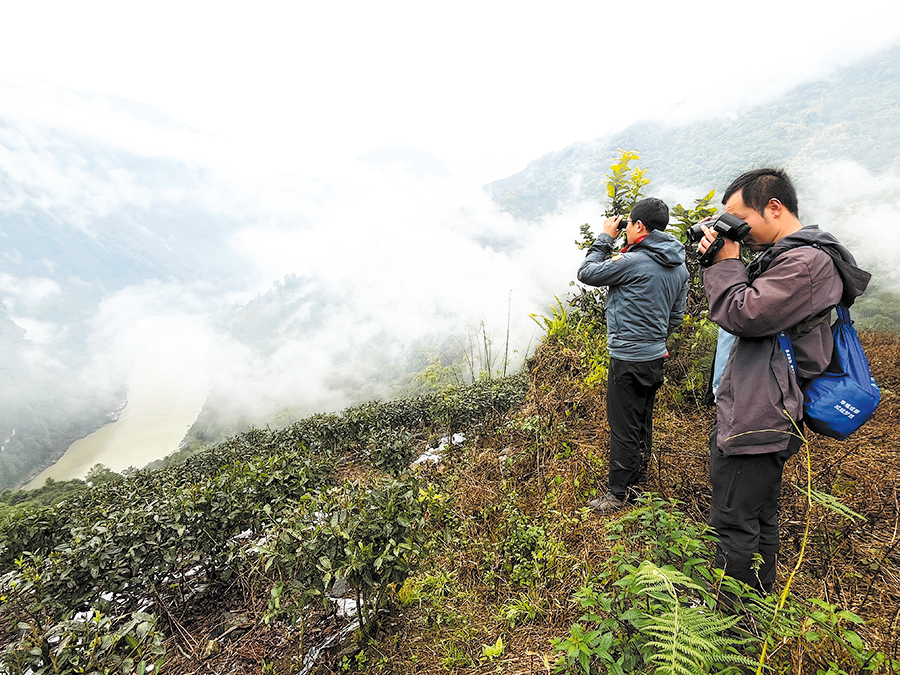Land of lush landscapes a paradise for nature lovers


For nature enthusiasts in China, Metog in Nyingchi city, Xizang autonomous region, stands as an irresistible magnet. Its abundant wildlife, diverse flora, remote setting and varied landscapes, spanning from coniferous forests against a backdrop of snowcapped mountains to lush subtropical jungles, captivate visitors so much that many are drawn back for repeat visits.
Among the eight members of the bird survey expedition led by ornithologists Chen De and Que Pinjia in the area last month, Que has visited the area four times. Huang Ke and Li Bin, two freelance surveyors, have each visited twice.
Since 2008, I have made four trips to Metog, twice for wildlife surveys as a journalist and twice just for leisure.
For all four of us, the number and variety of birds we observed during last month's survey were fewer than usual.
"As bird-watchers often say, the conditions for bird-watching in this season is not good, a little atypical," Que said."But it doesn't matter for scientific research. We can still compare this year's results with those recorded in previous years, analyze the reasons behind the results and try to gain deeper insight into the area's avian life."
Despite fewer birds, the survey was never boring, even though it was usually rainy and foggy.
Most of the time in Metog, I joined the survey led by Que, which involved counting birds along the roads. Using thermal scopes to scan the canopies, Que and Huang would find something from time to time during the survey. If they were not birds, they were mammals.
On the first day when Que and I joined the group, we found a herd of takins feeding on a sheer slope facing Zhamo Highway across the Yarlung Zangbo River.
I had seen the Sichuan subspecies of the huge hoofed mammal many years ago. But the subspecies distributed in this part of the country is different. It's the Bhutan subspecies and looks darker.
Monkeys, likely different species of macaques, were common. We saw them almost every day. While searching for owls in the evenings, we also found flying squirrels feeding on tender leaves in the canopies.
It was amazing to watch a bevy of red gorals, a bright foxy-red animal with long, soft and shaggy hair, running and feeding with ease on a sheer cliff overlooking the Yarlung Zangbo River. Another treat was finding an Asiatic black bear napping in its home built atop a tree that was 30 or 40 meters tall.
Even when the wildlife wasn't immediately visible, the area was still teeming with life. Blooming wildflowers, such as a variety of Rhododendron trees with flowers in different colors, and wild epiphytic orchids growing rampant on treetops with flowers hanging in the air, were so beautiful and captivating that we couldn't resist making stops to take photos of them.
"The abundance of mammals is an indicator of a healthy ecological system," Que said."Even though we failed to find some bird species this time, I am sure birds are still there. Metog is still a decent sanctuary for them."
Before concluding the survey, Chen and Que visited the local forestry bureau. A female official met them in her office.
There, the two were surprised to learn that despite the entire county being designated as part of the National Yarlung Zangbo Grand Canyon Nature Reserve since 2000, only six people are currently managing the county's conservation work.
"We have a permanent staff of 11, but some are studying in the inland provinces, and some are sick or on maternity leave," she explained."We are truly short of hands."
That explains why "we still feel a lack of comprehensive understanding of the area's fauna and flora", Que said.
"Almost all data on the area have been collected by various scientific expeditions over the years," he said."They are discontinuous and irregular, and therefore, incomplete."
As a result, the two ornithologists said that they would surely return to the area and continue to try to fill the research gap in the area's avian life.
Contact the writer at chenliang@chinadaily.com.cn
- China willing to advance just and equitable global anti-corruption system
- Chongqing hosts Silver Age fashion model competition
- Hengshan Mountain glistens with iconic winter rime scenery
- Ningbo hospital staff disciplined following pediatric surgery death
- Mainland warns Taiwan leader against provoking conflict
- Former senior official of Shenzhen under investigation





































